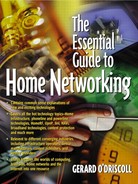BASIC PRINCIPLES
In wireless technology, data is transmitted over the air. Wireless solutions are ideal platforms for extending the concept of home networking into the area of mobile devices around the home. Consequently wireless technology is portrayed as a new system that complements phone-line and powerline networking solutions. It is likely that wireless technology will not emerge as a home network backbone solution, but will instead serve to interconnect the class of devices that need mobile communications into a subnetwork. These mobility subnetworks will interface with other subnetworks and with the Internet by connecting to the home network backbone. Wireless home networks transmit and receive data over the air, minimizing the need for expensive wiring systems. With a wireless-based home network, you can access and share expensive entertainment devices without pulling new cables through walls and ceilings. At the core of wireless communication is a device called a transmitter and one called a receiver. The user interacts with the transmitter—for example, one of the children in puts a URL into their PC. This input is then converted by the transmitter to electromagnetic (EM) waves and sent to the receiver, which could be built into the set-top box. The receiver then processes these electromagnetic waves. For two-way communication, each user requires a transmitter and a receiver. Consequently, many of the homes networking device manufacturers build the transmitter and receiver into a single unit called a transceiver. The operation and functionality of a wireless and wired home network remain the same; however, there are distinctions in the technologies used to achieve the same objectives.
The two main technologies used in wireless home networks are:
Infrared (IR)
Radio frequency (RF)
IR
Most of us are familiar with everyday devices that use IR technology: remote controls for TVs, VCRs, and CD players. IR transmission is categorized as a line-of-sight wireless technology. This means that the workstations and digital appliances must be in a direct line to the transmitter in order to operate. An infrared-based network suits environments where all the digital appliances that require network connectivity are in the one room. There are, however, new IR technologies being developed that can work out of the line of sight, so expect to see these products in the very near future. IR home networks can be implemented reasonably quickly; however, people walking across the room or moisture in the air can weaken data signals. IR in-home technology is promoted by an international association of companies called IrDA (Infrared Data Association). Further details on this organization are available at: http://www.irda.org/.
RF
The other main category of wireless technology is radio frequency. RF technology is a more flexible technology, allowing consumers to link appliances that are distributed throughout the house. RF can be categorized as narrow band or spread spectrum. Narrow band technology includes microwave transmissions. Microwaves are high-frequency radio waves and can be transmitted to distances of up to 50 km. Microwave technology is not suitable for home networks but is, however, used to connect networks in separate buildings. Spread spectrum technology (SST) is one of the most widely used technologies in wireless home networks. SST was developed during World War II to provide greater security for military communications. As it entails spreading the signal over a number of frequencies, spread spectrum technology makes the signal harder to intercept. There are a couple of techniques used to deploy SST; a system called frequency-hopping spread spectrum (FHSS) is the most popular technique for operating wireless home networks. FHSS transmissions constantly hop over entire bands of frequencies in a particular sequence. To a remote receiver not synchronized with the hopping sequence, these signals appear as random noise. A receiver can only process electromagnetic waves by tuning to the relevant transmission frequency. The FHSS receiver hops from one frequency to another in tandem with the transmitter. At any given time there may be a number of transceivers hopping along the same band of frequencies. Each transceiver uses a different hopping sequence that is carefully chosen to minimize interference on the home network. Because wireless technology has roots in military applications, security has long been a design criterion for wireless devices. Security provisions are normally integrated with wireless home networking devices, making them more secure than most wireline-based in-home networks. Complex encryption techniques make it nearly impossible for hackers to gain access to traffic on your wireless network.
When implementing a wireless home network, you need to install specific hardware to complete the connections. Similar to phone-line, IEEE 1394, and powerline networking, you need to connect your network nodes in the house to the transmission medium. To do this, you install a wireless NIC. The NIC hardware comprises a card with onboard transceiver, a fixed or external antenna, and cable connections. To install the card, you remove the cover of the digital appliance and slide the card into one of the free slots. To complete the hardware installation, connect a fixed antenna to the rear of the NIC. Or else connect an antenna cable for mounting an external antenna. Usually the external antenna is placed as high up as possible on the wall or on the ceiling to improve coverage. The antenna resembles a TV aerial, in the sense that where you locate it is important in relation to signal transmission and reception. In addition to installing the wireless NIC, you must also complete a number of software installation steps. This entails configuring and loading device drivers. If the nodes on the network are PCs with Windows 98, then the software configuration will be performed automatically. The layout of digital appliances on a wireless digital network is normally dictated by the physical layout of the house.
A number of industry initiatives are underway to develop interoperable wireless in-home appliances. The following sections describe the most popular of these technologies.
